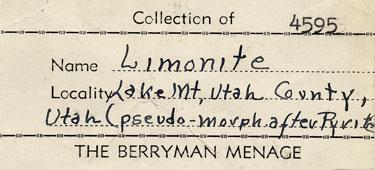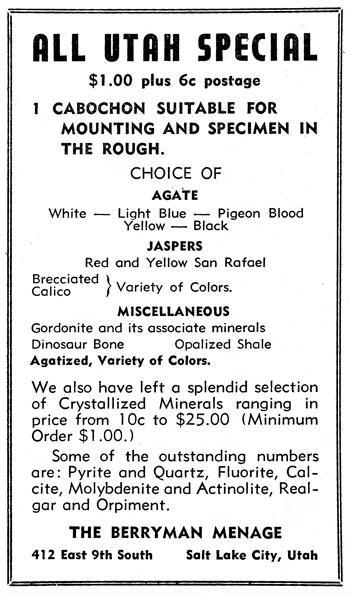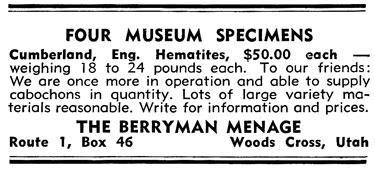Berryman, Mildred J. "Barrie" (1901-1972)
The Berryman Menage was a 1940's mineral and lapidary dealership in Salt Lake City, and Wood's Cross, Utah. Their first ad appeared in the October 1940 issue of The Mineralogist, announcing the opening of their new mineral showroom in their Salt Lake City residence at 412 East 9th. Subsequent ads appeared in Rocks & Minerals beginning in July 1941, offering "Superb Utah azurite" and "New Bingham pyrite." More ads appeared in The Mineralogist in February-May (Salt Lake City address) and September-December (Wood's Cross address) 1943. In April 1943 they offered "Superb specimens, limited quantity, amethystine quartz crystal groups, Arizona chrysocollas, Pyrite and quartz groups (Bingham)." In May they advertised gordonite and associated minerals from Fairfield, Utah. In September, following the move to Woods Cross, they offered "Four museum specimens, Cumberland, England Hematites. $50.00 each--weighing 18 to 24 pounds each."Their price list/bulletin in 1944 was called Berryman's Rock Pile.But who was “The Berryman Menage” (“ménage” meaning “household)? According to the Salt Lake City Directory, the 412 East 9th address corresponds to the address of Richard Gordon Berryman Sr. and his two children Richard Jr. and Mildred J. "Barrie" Berryman -- of which the principal movers in the mineral business appear to have been Richard Sr. and Mildred. In the July 1940 issue of The Mineralogist M. Barrie Berryman provided a competent article about a field trip by the Utah Mineralogical Society (of which she was an enthusiastic member) to the Wildcat Mountains in search of fluorite, and another in the July 1943 issue on "A Utah Locality." Editor Henry Dake mentioned that she "collects minerals and has a home lapidary shop."
Richard Sr. was born November 28, 1862 in Tronis, England, the son of William and Mamie Rowe Berryman. He emigrated from England with his family in 1867, and settled first in New Jersey. In the 1880's he drove a wagon across the Rocky Mountains and settled in Colorado Springs, then worked several years as a miner near Leadville, an occupation that introduced him to minerals and geology. He was also one of the first "vigilantes" in that area. While in Colorado, he met Mildred Stokes, a New York-born actress who was touring the United States. Richard and Mildred were married in Colorado Springs in 1892 and lived there for two more years before moving to Salt Lake City, Utah, where Richard first got work as a bartender for the Utah Liquor Company, located in the heart of Salt Lake City's red light district. They had three children: George (1896), Richard Jr. (1898), and Mildred (1901). After his wife's death in 1910, Richard Sr. and his children moved into the home at 412 East and 900 South. Richard Sr. continued working at the Utah Liquor Company until 1913, when he got a job tending bar at Hanak and Rumph, later called “the Opera Buffet” and “the Opera Bar.” He worked there until the 1920's when Prohibition forced him out of his job. In its earlier days, the Opera Bar had a significant homosexual clientele.
Richard's daughter Mildred Berryman entered Westminster College (a private school owned and run by the Presbyterian Church) in Salt Lake City in 1916, less than a month after turning 15. She lived in the all-female dormitory on campus, and enrolled in classes in the Bible, English, German, Art, Geography, History, and Spelling. Mildred then came out as a Lesbian, and announced that she wanted to do an academic thesis study of Lesbianism. This threw the college into an uproar, and several other female students were pulled out of school by their families. Although the faculty refused her thesis request, she was not expelled; traumatized by the scandal, however, she ran away at 16 and married a man in order to try to escape her homosexuality, but the marriage ended quickly. She continued her studies until 1919, and may have taken introductory classes in geology, mineralogy and chemistry.
In 1920 Mildred took a job as a stenographer, intending to devote herself to writing and science. In 1924 she worked for the De Lux Photo Company, where her brother also worked, and she later became a commercial photographer herself for the Superior Photo Company. Her father meanwhile began working at the Wasatch Municipal Hot Springs, where he would eventually become the engineering foreman, and work there until his health failed in 1942. Mildred, who was small and petite, loved wearing riding boots and masculine clothes. She became a long-time resident of a Lesbian boarding house for several years, had several female relationships in succession, and chose to go by the name of “Barrie.” In 1929 she moved back home with her brother and father, where she began writing her thesis on homosexuality (through which she hoped eventually to obtain a PhD), developing case studies of 24 women (including herself) and nine men.
By 1936 Mildred was doing so well as a photographer that she was able to open up her own studio in the family residence, and had a new live-in female partner. Nevertheless, while making her living as a photographer, Mildred aspired to be an author and scientist, probably a geologist. It is likely that her father had collected minerals since his mining days, and she now appears to have become involved as well, particularly in the lapidary and jewelry end. They opened a mineral and lapidary showroom in their home (which already housed Mildred's photography studio) in 1940. She continued her work as a photographer until 1941 or 1942, when wartime necessities led her into the defense industry. While working at a small arms factory, she met Ruth Uckerman Dempsey, a divorced Mormon housewife, who was working at the same plant. They began what was to be a long-term relationship. When Mildred and her ailing father moved up to Woods Cross (where the Berryman Menage advertised from, beginning in December 1943), a rural area just north of Salt Lake City, Ruth decided to move with her. In addition to the Berryman Menage business, Ruth and Barry began their own manufacturing company there, making tourist items for Indian jewelry, carved plastic items for displays, ribbons for fairs, etc. out of their shop, which they called "Berryman Novelty Manufacturing." They probably continued the family mineral sales from there as well. However, the ads for the Berryman Menage in The Mineralogist cease abruptly after December 1944, marking the death of Richard Sr.
Richard Berryman died on January 5, 1945 (services were provided by St. Paul's Episcopal Church). Ruth and Barry Berryman stayed together for 33 years. Mildred J. Berryman died of natural causes on November 7, 1972 at the age of 71. Her obituary states that she was a member of the Bountiful Community Church (Congregational/Episcopal), past president of the Business and Professional Women organization, and past president of the American Legion Auxiliary. Her thesis was ultimately published posthumously, at least in part, in the 1978 issue of Signs: Journal of Women in Culture and Society, and is today considered a valuable early study in homosexuality.
Reference: O'DONOVAN, C. (2004) Mildred J. "Barry" Berryman. http://home.earthlink.net/ ~heruliwolf/berryman.pdf
Click to images to view larger
To contribute more information please E-mail us at:
minrecord@comcast.net
Citation format for this entry:
WILSON, Wendell E. 2022
Mineralogical Record
Biographical Archive, at www.mineralogicalrecord.com
minrecord@comcast.net
Citation format for this entry:
WILSON, Wendell E. 2022
Mineralogical Record
Biographical Archive, at www.mineralogicalrecord.com
October 1940 ad in The Mineralogist announcing the opening of the Berryman Menage showroon in the Berryman home.






